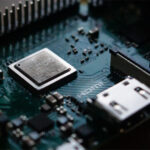As we look out onto the battlefields of the wars of tomorrow, will we see humanoid robots and AI-driven autonomous weapons instead of soldiers?
Unfortunately, humanity can’t hang up the fatigues and boots quite yet. While AI can process and distill vast amounts of data, it can’t truly “think” or react independently without huge amounts of power and the most advanced sensors. Even if chips and sensors advanced quickly, there remains mobility, stability, and power supply problems.
And allow me to kick this dead horse once more…the semiconductor supply chain is fragile and will fracture along with deglobalization. If everything went perfectly in developing the hardened, next-gen chips required for military applications, we still wouldn’t see those emerge until the 2030s. And that’s one big ass IF.
Transcript
Hey all, Peter Zeihan here. Coming to you from Colorado today. We are taking an entry from the Patreon Ask Peter a question page specifically. Yes, demographics are in decline. Yes, that is going to change a whole lot of things. But when it comes to military issues, won’t artificial intelligence and automation and above all, humanoid robots and androids be able to take the place of humans in the not too distant future, like, whoa, whoa, hold your horses.
Okay, so let’s assume for the moment that the supply chain for high end semiconductors does not break down. And that is a very poor bet. Just put that to the side. We are nowhere close. There’s two issues here. One is something that AI is reasonably good at and that is processing take huge amounts of data and processing and distilling it down.
That’s basically what ChatGPT has been doing for a while, and is getting incrementally better at. That is not the same as thinking. Thinking requires significantly more processing power than you can put, not in just one chip, but into a whole server blade of chips or a whole server stack of chips. You basically need an ongoing connection to a server farm, with all that processing and computing power, in order to do something that a proxy emits thought.
So taking data and distilling it or processing it sure. Thinking and reacting to your real life environment, that’s a whole different issue. And it is shaped by the data that you can feed in, which is not an AI issue or a chip issue. It’s a sensor issue. And our sensors are not nearly as good as anything else in the processing department.
That’s problem one. Problem two is much more direct. Let’s assume that your sensors are perfect. Let’s assume that we do have AI chips that are an order of magnitude more advanced that we have, right now. Let’s assume that maybe you can have a data link back to a data farm without any sort of jamming. And by the way, good luck with that movement, people.
Movement. You have to be able to have a device, an android, a robotic tank, whatever it happens to be that can loiter, that can operate at range without a whole lot of decision making that is done by humans. And the problem there is power and acuity.
Right now, lithium is the best battery system we have, and it can maintain a charge for a few hours of action for, say, an electric vehicle, which is nothing compared to what you are going to need when you talking about tracked vehicles or articulated joints.
The second issue is stability. Not only do you have to have good sensors to be able to perceive the environment, you have to be able to manipulate that environment. I’m sure a lot of you have seen that viral footage from about a year ago of a humanoid robot basically doing a back flip up and landing on the table behind him.
I was like, ooh, we’re about to be replaced. You know how many attempts that took? 11,000. 400. You know how many more attempts it took before I could do it again? Another 13,000. These things can’t learn. They can take actions. There are rules for them. Pack mule might not sound sexy. Kind of a big deal on things like desert warfare.
Autonomous weapons systems, though, are simply not anywhere close. And then I have to go back to that thing that I said we were going to ignore. And that’s whether or not the chips are going to get better. The highest end chips we have right now are rapidly approaching one nanometer, but they require 30,000 pieces and 100,000 manufacturing supply chain steps and 9000 companies.
And over half of these things are single point failures. It doesn’t take a significant shift in the international environment to make a few of them fall out of the constellation, and when that happens, no more chips will be made. Not to mention that the chips, as they are existing right now, are designed for measures that we already have.
Things we already need, things we already use, which means that they’re not shuck tested, they can’t handle vibration, they can’t handle temperature variation. They certainly can’t handle things like dust. We would have to first design a fundamentally new chip that is far more advanced than anything we have already that incorporates this sort of hardening into it. We haven’t even started that design process and assuming that everyone got it all right on their first try, you would see your first volume run of those chips come online probably around 2033.
So no, not something I worry about.









